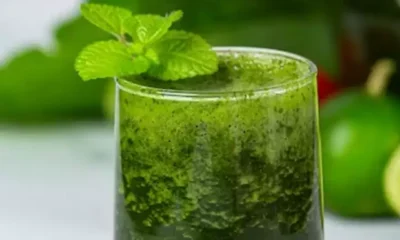DRINKS
11 Health Benefits Of Beetroot Juice
Published
6 months agoon

Beetroot juice is enriched with compounds, including antioxidants and electrolytes, that have been associated with various health benefits, particularly supporting cardiovascular and brain health.
Despite the beet’s polarising taste, this bulbous and sweet root vegetable has gained superfood status in recent years. Scientific studies indicate that the consumption of beet juice can have positive effects on health, and the following outlines some of these potential benefits.
Let’s see some of these benefits below:
1. Helps lower blood pressure
Consuming beet juice may contribute to reducing blood pressure. A meta-analysis conducted in 2022 found that the nitrates found in beetroot juice have the effect of lowering systolic blood pressure, particularly in adults with hypertension.
Nitrates, which are present in beet juice, undergo conversion into nitric oxide in the bloodstream, promoting the widening and relaxation of blood vessels.
2. Improves exercise stamina
Taking beet juice has been associated with increased plasma nitrate levels and improved physical performance.
A comprehensive research review conducted in 2017 indicated that sustained consumption of beetroot juice, spanning over 5–6 days, may yield several benefits, including:
- increasing performance in time trials
- increasing the amount of time to reach exhaustion
- improve cardiorespiratory performance
Findings from a 2016 study proposed that the daily intake of 70 mL (one-third cup) of beetroot juice for one week could enhance exercise tolerance in older adults experiencing heart failure.
The study observed a notable 24% improvement in aerobic exercise endurance among the participants.

4. It helps to maintain a healthy weight
Pure beet juice is low in calories and contains virtually no fat, making it an excellent addition to your morning smoothie for a nutrient and energy boost.
However, it’s important to be aware that it is high in natural sugars.
5. Prevents cancer
The vibrant colour of beets is attributed to betalains, water-soluble antioxidants. Additionally, beets contain various flavonoids and polyphenolic compounds that possess antioxidant and anti-inflammatory properties.
These components, including betalains, play a role in neutralizing and eliminating free radicals, unstable molecules that, when present in large quantities, can contribute to inflammation and elevate the risk of cancer.
Beetroot juice offers chemoprotective properties, potentially minimising the side effects and harm induced by chemotherapy, including fatigue.
7. A good source of potassium
Beets provide a good source of potassium, a mineral and electrolyte essential for proper nerve and muscle function. Drinking beet juice in moderation can help maintain optimal potassium levels.
Low potassium levels may cause fatigue, weakness, and muscle cramps, while very high levels can lead to life-threatening heart rhythm abnormalities.
Individuals with chronic kidney disease should consult a healthcare professional before regularly consuming beet juice, as they may need to follow a low-potassium diet.
8. A good source of other minerals
Essential minerals are crucial for proper bodily function. They play a role in supporting the immune system, maintaining healthy bones and teeth, and ensuring overall well-being.
Beet juice, in addition to potassium, provides these essential minerals, like:
- iron
- magnesium
- manganese
- sodium
- zinc
- copper
- selenium

9. A good source of folate
Folate, a B vitamin, plays a crucial role in preventing neural tube defects like spinal bifida and anencephaly. It can also reduce the risk of premature births.
Beet juice serves as a good source of folate, making it a valuable addition to the diet, particularly for pregnant individuals aiming to meet the recommended daily intake of 600 micrograms.
10. Supports the liver
The antioxidant betaine may have the potential to prevent or reduce fatty deposits in the liver.
Additionally, betaine might offer protection against liver toxins, although further research is required. Fatty deposits in the liver can contribute to a condition called nonalcoholic fatty liver disease, characterized by:
- a poor diet
- excessive alcohol consumption
- exposure to toxic substances
- sedentary lifestyle
11. Reduces cholesterol
If you have high cholesterol, incorporating beet juice into your diet might be beneficial. The betanin in beetroot juice could potentially lower LDL, commonly known as “bad” cholesterol.
Beetroot juice has a positive impact on both LDL and HDL, often referred to as “good” cholesterol.
Beetroot’s cholesterol-lowering potential is due to its phytonutrients, including flavonoids.
Get the latest and greatest updates right away! Join our exclusive WhatsApp channel and never miss out on exciting news again.
Precautions
Consuming beets may cause your urine and stools to appear red or pink, a harmless condition known as beeturia. However, it might be surprising if you’re not anticipating it.
If you have low blood pressure, regular consumption of beet juice could increase the risk of your blood pressure dropping excessively. It’s crucial to monitor your blood pressure carefully.
For individuals prone to calcium-oxalate kidney stones, avoiding beet juice may be necessary. Beets are high in oxalates, natural substances that can form crystals in urine and contribute to the formation of stones.
Is it OK to drink beet juice every day?
Regularly consuming beet juice can offer essential nutrients like antioxidants, vitamins, and minerals, supporting overall health.
Drinking it every day is considered fine and may contribute to reducing inflammation and enhancing exercise stamina, among other potential benefits.
What is beet juice good for?
Beet juice offers numerous health benefits, including:
- May aid in lowering blood pressure.
- May contribute to reducing LDL, or “bad” cholesterol.
- Can enhance exercise stamina.
- May improve muscle strength in individuals with heart failure.
- Assists in maintaining a healthy weight.
- It helps prevent or reduce fatty deposits in the liver.
- Excellent source of potassium and essential minerals like iron and manganese.
- May have cancer-preventive properties.
- May provide support during chemotherapy.

Does beet juice detox your body?
Your body has a natural detoxification process involving organs like the kidneys, liver, and digestive system, making specific detox diets unnecessary.
Beet juice, while not a detox solution, contains nutrients that can support overall health when included in a balanced diet.
Is there a downside to drinking beet juice?
A 2020 study revealed that beetroot juice contains high nitrate concentrations, which are converted into nitric oxide in the body.
Nitric oxide has various functions, including lowering blood pressure and enhancing oxygen and nutrient delivery to muscles and organs.
Exceeding the recommended daily nitrate intake may pose potential downsides, leading to the formation of carcinogenic N-nitroso compounds and other adverse effects.
However, researchers emphasised the need for more extensive research to accurately assess the negative effects of beetroot juice.
Does beetroot juice really lower your blood pressure?
Yes, the nitrates present in beets can notably reduce blood pressure.
Both raw beetroot juice and cooked beets have shown effectiveness in lowering blood pressure, with raw beet juice exhibiting a greater impact.
Are the benefits of beetroot juice different for men and women?
Beetroot juice contains polyphenols, nitrates, and minerals that may contribute to supporting overall health, regardless of gender.
Further research is required to understand how these benefits may differ between sexes.
Takeaway
Beets are nutritious, regardless of how you choose to prepare them.
If the taste of straight beet juice is not to your liking, consider incorporating apple slices, mint, citrus, or a carrot to balance out the earthy flavour.
When introducing beet juice to your diet, start gradually. Begin by juicing half a small beet and observing how your body reacts. Gradually increase the quantity as your body becomes accustomed to it.
If you would like more articles on drinks, check here.

Coffee culture is the social atmosphere, traditions, and practices that have developed around the consumption of coffee. This culture has evolved over centuries and varies significantly across countries and regions.
Let’s explore the fascinating world of coffee culture in detail below.
The Origins of Coffee Culture
Coffee culture has its roots in the Middle East, where coffee was first cultivated and consumed. In the 15th century, coffee houses appeared in cities like Cairo and Constantinople (now Istanbul). These establishments quickly became centres of social interaction, intellectual discourse, and political debate.
The concept of the coffee house then spread to Europe in the 17th century, sparking a new era of coffee consumption and socialization.
The Global Spread of Coffee Culture
As coffee’s popularity grew, it spread to different parts of the world. Each region developed its own unique coffee traditions and preparation methods. In Italy, espresso became the preferred form of coffee, leading to the creation of drinks like cappuccino and latte.
A strong, unfiltered coffee served in small cups became a cultural staple in Turkey. In Vietnam, coffee is often served with sweetened condensed milk, creating a rich and sweet beverage.

The American Coffee Shop Revolution
In the United States, coffee culture underwent a significant transformation in the late 20th century. The rise of speciality coffee shops, led by chains like Starbucks, introduced Americans to a wide variety of coffee drinks and created a new social space centred around coffee consumption. These shops offered a “third place” – neither home nor work – where people could meet, work, or simply relax.
Coffee Preparation
Coffee culture has given rise to various methods of coffee preparation, each with its own devotees. Espresso machines create concentrated shots of coffee, forming the base for many popular drinks. French presses allow coffee grounds to steep in hot water before being filtered out.
Pour-over methods, where hot water is manually poured over ground coffee in a filter, have gained popularity among coffee enthusiasts for the control they offer over the brewing process.
The Rise of Specialty Coffee
In recent years, there has been a growing interest in speciality coffee. This term refers to high-quality coffee beans that are carefully sourced, roasted, and prepared to bring out their unique flavours.
Speciality coffee shops often focus on educating customers about the origin of their beans, the roasting process, and different brewing methods. This has led to a more informed and discerning coffee consumer base.
Coffee and Social Interaction
Coffee continues to play a significant role in social interactions around the world. In many cultures, inviting someone for coffee is a common way to suggest a casual meeting or date.
Coffee breaks in workplaces provide opportunities for coworkers to socialize and relax. Coffee shops serve as meeting places for friends, study spots for students, and workspaces for remote workers.
The Ritual of Coffee Consumption
For many people, drinking coffee is not just about caffeine intake, but a daily ritual that provides comfort and structure. The act of preparing and consuming coffee can be a mindful practice, offering a moment of pause on busy days.
Some people have elaborate morning coffee routines, while others enjoy an afternoon espresso as a pick-me-up.

Coffee and Creativity
Coffee shops have long been associated with creativity and intellectual pursuits. Many writers, artists, and thinkers have found inspiration in these spaces.
The ambient noise of a coffee shop has even been shown to enhance creative thinking for some people. This connection between coffee and creativity continues to be an important aspect of coffee culture.
The Environmental Impact of Coffee Culture
As coffee consumption has increased globally, so too has awareness of its environmental impact. Many coffee drinkers now seek out sustainably sourced and ethically produced coffee. This has led to the growth of fair trade and direct trade practices in the coffee industry.
Additionally, there’s been a push towards more eco-friendly packaging and a reduction in single-use cups and plastics in coffee shops.
Coffee Culture and Technology
Technology has also influenced coffee culture in recent years. Mobile apps allow customers to order and pay for their coffee in advance, reducing wait times. Social media platforms have become spaces for coffee enthusiasts to share their experiences and discoveries.
Some coffee machines now come with smart features, allowing users to control them remotely or program custom brewing schedules.
The Future of Coffee Culture
As coffee culture continues to evolve, several trends are emerging. There’s growing interest in cold brew and nitro coffee, which offer different flavour profiles and drinking experiences. Plant-based milk alternatives are becoming increasingly popular in coffee drinks. Some coffee shops are experimenting with coffee cocktails, blending coffee culture with bar culture.
In conclusion, coffee culture is a rich and diverse phenomenon that touches many aspects of society. From its humble beginnings in the Middle East to its current global status, coffee has shaped social interactions, work habits, and even urban landscapes.
As coffee culture continues to evolve, it will undoubtedly remain an important part of daily life for millions of people around the world, offering not just a caffeine boost, but a sense of comfort, community, and ritual.
For more articles like this, visit here.

Tear gas is a chemical irritant used in some situations to control crowds. If you’ve been exposed to tear gas, it’s important to know what to eat and drink to help your body recover. This article will guide you through the best foods and drinks to have after tear gas exposure.
Why food and drink choices matter after tear gas exposure
After tear gas exposure, your body needs help to heal. The right foods and drinks can:
- Reduce inflammation (swelling) in your body
- Help flush out the harmful chemicals
- Boost your immune system (the body’s defence system)
- Provide comfort and relief
Hydration: the most important step
Drinking plenty of water is the single most important thing you can do after tear gas exposure. Water helps to:
- Flush out the tear gas chemicals from your body
- Keep you hydrated (having enough fluids in your body)
- Soothe your throat if it’s irritated
Aim to drink at least 8-10 glasses of water in the hours after exposure. Keep drinking water regularly throughout the next few days.
Other hydrating drinks include:
Coconut water
This is a good choice because it has natural electrolytes (minerals that help with hydration), is gentle on your stomach, and can help replace fluids you’ve lost.
Herbal teas
Some helpful herbal teas include:
- Chamomile tea: It can help calm your nerves and reduce inflammation.
- Ginger tea: This can help with nausea and has anti-inflammatory properties.
- Green tea: It’s full of antioxidants that can help your body heal.
Avoid caffeinated drinks like coffee or regular tea, as these can dehydrate you.
Fruits and vegetables
Fruits and vegetables are important because they contain vitamins and minerals that help your body heal. They have antioxidants that fight inflammation. Also, they provide fibre to help your digestive system.
Some good choices are:
- Berries (strawberries, blueberries, raspberries)
- Citrus fruits (oranges, grapefruits) (Wait a day or two if your throat is sore)
- Leafy greens (spinach, kale)
- Carrots
- Bananas – these are another soft and easy-to-eat option. They’re also a great source of potassium, a mineral that can help replenish electrolytes lost through sweating or irritation.
Soups and broths
Soups and broths are a great choice after tear gas exposure for a few reasons. First, if your throat is sore and swallowing is painful, broths and soups are very easy to swallow. They’re nice and smooth, going down gently without irritating your throat further.
Second, broths and soups provide extra fluids to your body. This is important because tear gas can dehydrate you, and staying hydrated helps your body flush out the tear gas chemicals.
You can make your own vegetable soup packed with chopped carrots, celery, and spinach, or simply have some clear chicken broth for a quick and easy option. Both will help you rehydrate and feel better.
If your mouth or throat feels irritated and sore after tear gas exposure, some gentle foods can help soothe the discomfort and make eating a little easier.
Yoghurt
This is soft and cool food that’s easy to swallow. It’s also a good source of probiotics, which are live bacteria that help keep your gut healthy. Having healthy gut bacteria can be helpful during recovery because it supports your immune system.
Foods to avoid after tear gas exposure
While your body heals from tear gas exposure, it’s best to avoid certain foods that can irritate your throat and stomach even more.
Spicy foods
Put down the hot sauce for a few days! Spicy foods irritate your throat and stomach lining, which can already be inflamed from the tear gas. This will make you feel more uncomfortable and might even cause heartburn.
Acidic foods
Take a break from those tangy tomatoes and citrus fruits (except maybe strawberries if your throat feels alright). Acidic foods irritate your already sore throat, making it feel scratchy and painful. Wait a day or two after exposure before having these again.
Vinegar-based foods
Similar to acidic fruits, dressings, marinades, and condiments with vinegar can irritate your throat. It’s best to avoid them for a few days after tear gas exposure.
Dairy products
Some people find that dairy products, like milk, cheese, and yoghurt, can increase mucus production. This can make congestion worse, especially if you’re already experiencing a runny nose or post-nasal drip from the tear gas. If you notice more mucus after consuming dairy, avoid it for a few days and see if your symptoms improve.
Alcohol
Hold off on that celebratory beer! Alcohol is dehydrating, and you need plenty of fluids to flush out the tear gas chemicals. Drinking alcohol can also worsen your overall discomfort and slow down your healing process. It’s best to wait at least 24 hours after exposure before consuming any alcohol.
Additional tips
- Eat small, frequent meals if your stomach is upset.
- Choose foods that are room temperature or cool, not very hot.
- Listen to your body: If a food doesn’t feel good, don’t eat it.
In conclusion…
After tear gas exposure, focus on staying hydrated and eating foods that will help your body heal. Drink plenty of water and herbal teas. Eat lots of fruits and vegetables, and choose soft, gentle foods if your throat is sore.
Avoid spicy, acidic foods and alcohol. With the right food and drink choices, you can help your body recover more quickly from tear gas exposure.
For more articles like this, visit here.

Kunu drink, also known as kunun zaki, is a popular traditional Nigerian beverage made from grains such as millet, sorghum, or maize. This refreshing and nutritious drink is often enjoyed for its slightly tangy flavour and health benefits.
Kunu is particularly cherished in Northern Nigeria, where it is commonly served during special occasions and as a thirst quencher on hot days. Below is a step-by-step guide on how to make kunu drink at home.
Ingredients for making Kunu drink
- To make Kunu, you’ll need the following ingredients:
- 2 cups of millet (you can also use sorghum or maize)
- 1 medium-sized sweet potato or a few slices of ginger (optional, for flavour)
- 1 teaspoon of cloves
- 1 teaspoon of black peppercorns
- 1 teaspoon of dry chilli pepper (optional, for a spicy kick)
- Sugar or honey to taste
- Water
Equipment you’ll need
- A large bowl
- A blender or food processor
- A fine sieve or cheesecloth
- A large pot
- A stirring spoon

How to make Kunu drink
Step 1: Soak the grains
1. Clean the grains: Start by cleaning the millet thoroughly. Remove any stones, dirt, or impurities.
2. Soak the grains: Place the cleaned millet in a large bowl and cover with water. Let it soak for at least 8 hours or overnight. This helps to soften the grains and makes blending easier.
Step 2: Blend the mixture
1. Prepare the spices: While the grains are soaking, you can prepare the spices. Peel and chop the sweet potato or ginger into small pieces.
2. Blend the grains and spices: Drain the soaked millet and transfer it to a blender. Add the chopped sweet potato or ginger, cloves, black peppercorns, and dry chilli pepper if using. Add enough water to cover the ingredients and blend until you get a smooth paste.
Step 3: Strain the mixture
1. Strain the paste: Pour the blended mixture into a large bowl lined with a fine sieve or cheesecloth. Strain the mixture, squeezing out as much liquid as possible. This liquid is the kunu extract.
2. Repeat if necessary: If the mixture is too thick to strain, you can add a little more water and blend again before straining.
Step 4: Cook the Kunu
1. Heat the Kunu extract: Pour the strained Kunu extract into a large pot. Add more water if necessary to achieve your desired consistency. Kunu should be thick but drinkable.
2. Cook the mixture: Heat the pot over medium heat, stirring constantly to prevent lumps from forming. Cook the mixture for about 10–15 minutes until it thickens slightly and becomes smooth.
3. Cool the Kunu: Remove the pot from the heat and allow the kunu to cool completely.
Step 5: Sweeten and serve
1. Sweeten the Kunu: Once the kunu has cooled, add sugar or honey to taste. Stir well to ensure the sweetener is fully dissolved.
2. Chill the drink: Transfer the kunu to a refrigerator and chill for at least an hour before serving. Kunu is best enjoyed cold.

Tips for making Kunu drink
- Experiment with flavours: You can customise your Kunu drink by adding different spices or flavours, such as cinnamon, nutmeg, or vanilla.
- Adjust the consistency: If you prefer a thicker or thinner drink, adjust the amount of water used during blending and cooking.
- Storage: Kunu drink can be stored in the refrigerator for up to a week. Stir well before serving, as it may settle over time.
Health Benefits of Kunu drink
Kunu is not only delicious but also nutritious. It is rich in fibre, vitamins, and minerals, making it a healthy addition to your diet. The spices used in Kunu, such as cloves and ginger, also offer various health benefits, including anti-inflammatory and digestive properties.
In conclusion, making Kunu drink at home is a simple process that involves soaking, blending, straining, and cooking grains with spices. This traditional Nigerian drink is a delightful way to enjoy the flavours and health benefits of millet, sorghum, or maize.
Whether you’re new to Kunu or a long-time fan, this guide will help you create a refreshing beverage that everyone can enjoy.
Latest


New Album: KCee Releases Feat. Odumodublvck, Teni, Diamond Platnumz – ‘Mr. Versatile’
KCee has a new album called “Mr. Versatile“. This name shows that KCee is good at doing many different types...


Yemi Alade Releases Her Sixth Album, ‘Rebel Queen’
Yemi Alade has just released a new album called “Rebel Queen“. She is a famous singer from Nigeria, known all...


Ayra Starr Launches Doll Collection
Ayra Starr is a famous singer from Nigeria. She has become very popular in the music world. Many people like...


Musician Khaid Returns To Social Media After Protracted Illness; Unfollows All But Olamide
Khaid, a rising Nigerian music star, has recently returned to social media after a period of absence due to a...


Netflix Subscription Prices Increases In Nigeria For The 2nd Time This Year
Netflix has significantly increased its subscription fees for Nigerian users. This marks the second time the popular streaming platform has...


BBNaija 9: You Must Know These 4 Things Before The New Season Of Starts On Sunday
Africa’s most popular reality TV show, Big Brother Naija, is about to launch its ninth season (BBNaija 9) in a...


Burna Boy To Mark The 5th Anniversary Of ‘African Giant’ With YouTube Special
Burna Boy is a prominent African musician who has achieved global superstar status through his award-winning music and record-breaking concerts....


Babatunde Apalowo’s ‘Londoner’ Wins Best Fiction Feature Prize At Durban FilmMart
“Londoner” is an autobiographical film that tells the story of Ayo, a Nigerian bank manager who moves to London to...


Davido Partners With GAC Motors In Multi-Million Deal
David Adeleke, who is famously known as Davido, has entered into a new business agreement with GAC Motors, a well-known...


KCee Teases Release Of New Album, “Mr. Versatile”
KCee is a well-known Nigerian musician who has been making popular music for almost 20 years. He has managed to...
-Ad-




10 Reasons Why Working Out Is Good For You

New Music: BoyPee, Hyce & Brown Joel Feat. Davido – Ogechi

10 Lace Gown Styles To Steal The Show At A Wedding

Why Women Break Up With Men They Are Still In Love With

Shakira To Perform At 2024 Copa América Final On Sunday

My Wedding Dress Is The Most Comfortable Dress I’ve Ever Worn – Sharon Ooja Appreciates Designer Veekee James

Why ‘Isiagu’ Styles Are Becoming Norm At Igbo Ceremonies

Why Do Women Live Longer Than Men? See Reasons Behind The Longevity Gap

6 Ways To Stay Informed Without Sacrificing Your Mental Health

5 Things You Should Always Keep Private
Trending
-

 ARTS & CULTURE6 days ago
ARTS & CULTURE6 days ago5 Powerful Goddesses Who Answer Prayers In Nigerian Traditional Religions
-

 BEAUTY5 days ago
BEAUTY5 days agoHair Care Tips For All Nigerian Hair Types
-

 FAB FRESH4 days ago
FAB FRESH4 days agoRising Artist Litovibes Features Patoranking In New Single, ‘My Way’
-

 FASHION7 days ago
FASHION7 days agoWhat Qualifies As Distressed Fashion?
-

 SPORTS3 days ago
SPORTS3 days agoNigeria Vs Brazil: Time And Where To Watch The Super Falcons’ 1st 2024 Olympics Game
-

 FASHION6 days ago
FASHION6 days agoSuit Up & Stand Out: How To Wear A Head-Turning Suit In 2024
-

 HEALTHY LIVING5 days ago
HEALTHY LIVING5 days agoWhy Fibroids Come Back After Surgery
-

 OPINION6 days ago
OPINION6 days agoHow To Build Trust For A Stronger Relationship













